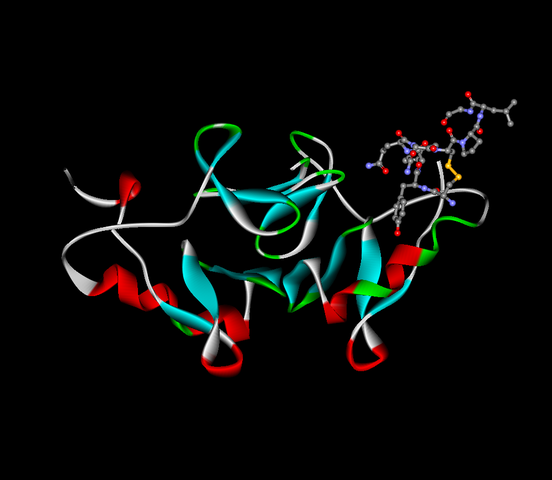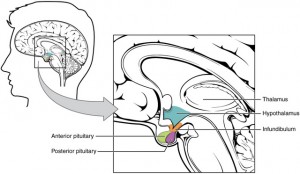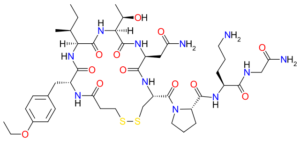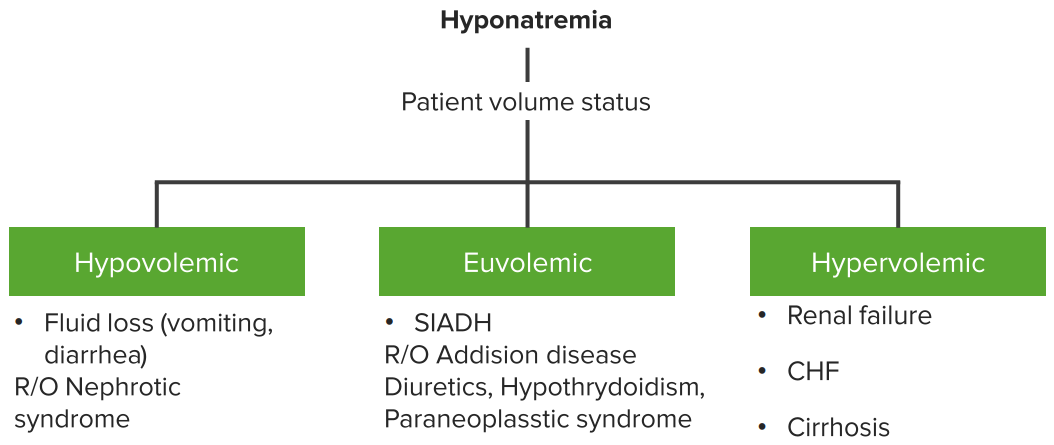Types of Peptide Hormones: Oxytocin and Vasopressin
In Lecturio ;) - The posterior pituitary secretes two hormones, oxytocin and vasopressin (anti-diuretic hormone). The word oxytocin literally means "quick birth" in Greek, which is an accurate description of the hormone's action. The following article discusses the positive and negative effects of oxytocin and vasopressin as well as their use as therapeutic options.
Table of Contents
Image : “Oxytocin (ball-and-stick) bound to its carrier protein neurophysin (ribbons).” by Edgar181. License: Public Domain
Oxytocin
Oxytocin is synthesized in the paraventricular nuclei of the hypothalamus. Like most other hormones, the synthesized form is an inactive precursor protein, from which the successive hydrolysis leads to the release of the final active oxytocin.
Neurophysin 1 is the characteristic precursor carrier protein, which is present in the precursor state. It should be noted that the secretion does not occur at the place of synthesis. The transport of the synthesized hormone occurs to the posterior pituitary gland via the stalk.
The characteristic storage bodies of oxytocin in the posterior pituitary are known as Herring bodies.They are present at the axon terminal in the posterior pituitary. The release of oxytocin from the end of the posterior pituitary requires a depolarizing signal to the nerve terminal.
One of the characteristic proteins which are required for the hydrolysis of oxytocin is the peptidylglycine alpha-amidating monooxygenase. This enzyme, in turn, requires vitamin C as the necessary cofactor. Oxytocin gets metabolized by means of an enzyme known as oxytocinase.
Though the posterior pituitary forms the major neural source of oxytocin, it should be noted that there are non-neural sources of oxytocin as well, like the corpus luteum and placenta in females and Leydig cells in males.
Function of oxytocin
Oxytocin is important in parturition as it stimulates uterine contractions and in breastfeeding as it induces myoepithelial contractions. Oxytocin, which is usually released via the suckling reflex, stimulates the contraction of the smooth muscle cells in the lactiferous ducts causing milk to let down. Prolactin is responsible for the production of milk, whereas oxytocin is responsible for the milk ejection.
In both instances, there is a positive feedback loop involved in their release. Uterine contractions are prompted and further promoted, by the uterine stretch, while breast myoepithelial contractions are promoted by the suckling action of the infant. The positive feedback loop is a characteristic feature of oxytocin as other endocrine hormones generally have a negative feedback loop. Ferguson reflex refers to the release of oxytocin on the dilation of the cervical and vaginal region.
Oxytocin in Labor
Mechanism of action of oxytocin in the uterus
Physiological uterine contractions are produced by oxytocin, with the law of priority being maintained (it should be noted that ergometrine causes complete loss of polarity during its contraction). The onset of action is also faster with oxytocin when compared to ergometrine, but it is short lived.
At the biochemical level, oxytocin acts through the G-protein coupled receptor, which functions via the phosphatidylinositol calcium channel. This, in turn, leads to the release of prostaglandins and leukotrienes. Oxytocin increases both the frequency as well as the force of contraction of the uterus, and only at higher doses causes prolonged and sustained contractions.
The duration of action of syntocinon lasts for 8 minutes. Another prime difference, when compared to ergometrine, is that syntocinon is available only by the parenteral route, whereas ergometrine is available in an oral formulation in addition to the parenteral route.
Clinically, oxytocin is used for the induction of labor and it also helps in the labor augmentation. In the case of postpartum hemorrhage, it is used along with ergometrine.
Therapeutic Uses of Oxytocin
Role of oxytocin in pregnancy
Oxytocin is used during pregnancy to accelerate abortion, especially in the case of missed abortion and the case of expulsion of the hydatidiform mole. It is also used for ripening of the cervix before the induction of labor and in the case of uterine inertia.
Role of oxytocin in males
The oxytocin receptors are found in the epididymis, and research has shown that it increases the motility and number of the sperm. It also helps in the conversion of dihydrotestosterone.
Diagnostic role of oxytocin
Oxytocin is used for diagnosis in the contraction stress test and oxytocin sensitivity test, which is currently not routinely used.
Future therapeutic options
Oxytocin is researched as a major trust-producing hormone. In a lighter note, it has been tried as a love-making hormone, confidence-generating hormone and has been used in relationship counseling.
In lactation deficiency, the nasal spray formulations of oxytocin have been tried.
Oxytocin nasal spray has been tested in cases of depression and many other social disorders. It is currently in the clinical trials for a variety of psychiatric disorders like schizophrenia and autism.
Side Effects and Contraindications of Oxytocin
The side effects of oxytocin are hyperstimulation of the uterus, water intoxication due to the antidiuretic effect (structural similarity with the vasopressin), rupture of the uterus, hypotension, and pain of the anginal variety. All these will also have an effect on the fetus, leading to fetal distress, hypoxia and even fetal death.
Available evidence shows that for the augmentation of a delayed labor, the high dose regimen of oxytocin will be reducing the length of the labor as well as the number of cesarean sections. In addition, it also increases the vaginal birth, which will occur spontaneously. Whereas in the case of induction of labor, the high dose and low dose have not shown any significant differences.
The contraindication for giving oxytocin include cephalopelvic disproportion, malposition of the fetus, hypertonic uterine pattern and any other contraindication for the vaginal delivery.
Atosiban
Image: “Skeletal diagram of atosiban.” by JaGa – self-made using BKChem and Inkscape. License: CC BY-SA 3.0
Atosiban, on the other hand, an oxytocin receptor antagonist, can be used as a tocolytic in the uncomplicated premature labor. It is available in Europe but not the United States. It acts as a second line of treatment after nifedipine (which is most commonly used for the preterm labor in between 32nd to 36th week). The efficacy of atosiban in a meta-analysis has been compared to that of beta agonists.
Vasopressin
Anti-diuretic hormone (ADH) is synthesized in the suprachiasmatic nuclei of the hypothalamus. It should be noted that the secretion does not occur at the place of synthesis. The synthesized hormone is transported to the posterior pituitary gland via the stalk. When the impulse for secretion arises, it occurs from the posterior pituitary. At supra-physiologic levels, ADH acts on V1 receptors to cause vasoconstriction, hence the term vasopressin.
Function of vasopressin
Image: “Chemical structure of vasopressin (argipressin, arginine vasopressin).” by Edgar181 – Own work. License: Public Domain
Vasopressin’s primary function is in the retirement of the water in the body and the constriction of the blood vessels. ADH release normally occurs following stimulation of osmoreceptors, usually due to increased plasma osmolality. ADH acts on V2 receptors at the distal kidney tubule and the collecting duct by causing insertion of aquaporin channels, thus increasing their permeability to water.
The resulting increased permeability of the collecting ducts causes reabsorption of water to occur. Water enters the hypertonic interstitium of the renal pyramids, thus concentrating the urine. In the absence of ADH, the urine is hypotonic to plasma (dilute urine), urine volume is increased, and there is net water loss leading to the increased osmolality of body fluids.
Other functions of vasopressin
- ADH also promotes the release of von Willebrand factor and factor VIII from the endothelium.
- Though most of the vasopressin is released into the blood vessels from the posterior pituitary, some amount is released directly into the brain. This raises the question about the importance of vasopressin in many other complex social behaviors and maternal responses (areas still to be explored).
- The vasoconstriction function of vasopressin, though not of great significance in effect in normal healthy individuals, plays an important role in hemorrhage patients with shock. The compensation by means of vasoconstriction results in pressure increase due to raising the peripheral vascular resistance.
- Vasopressin also plays an important role in the circadian rhythm. It also has its effect on the release of corticosteroids from the adrenal gland (along with the CRH).
Vasopressin Deficiency
The decrease in vasopressin secretion, as well as the alteration in the effect of vasopressin in the kidney, result in a characteristic disease known as diabetes insipidus.
The increased secretion leads to hyponatremia, and when it occurs as a result of hypovolemia,it would lead to the hypovolemic hyponatremia. In addition to this, there exist euvolemic hyponatremia as well as hypervolemic hyponatremia. The latter occurs in conditions such as nephrotic syndrome and heart failure.
The inappropriate secretion of ADH in the case of euvolemic hyponatremia is known asSyndrome of inappropriate antidiuretic hormone secretion (SIADH). The causes include small cell carcinoma of the lung as well as a number of drugs such as SSRI and tricyclicantidepressants.
Vasopressin as a therapeutic drug
Pharmacologically, vasopressin analogs are used in the management of von Willebrand Disease (vWD) type I and Hemophilia A. They are the second line of choice in shock patients after the failure of response to norepinephrine and dopamine.





Comentários
Enviar um comentário